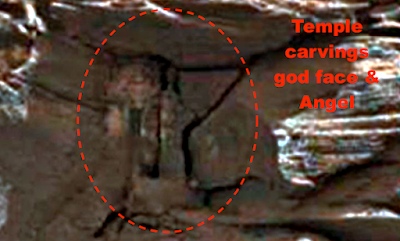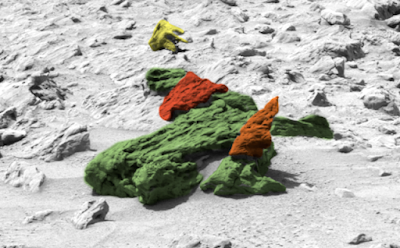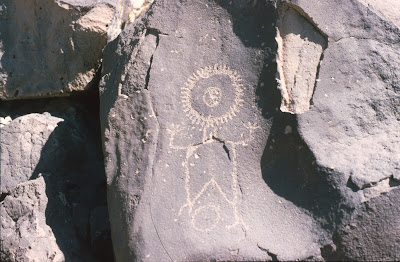Petroglyphs at Petroglyph National Monument, Albuquerque, New Mexico. From Ruskamp, 2017.
Abstract symbols from two locations in
the American Southwest have been supposedly translated and read as 2500 year
old Chinese inscriptions. This, from a publication by the Early Sites Research
Society, a group of fringies which advocates a large number of eccentric
beliefs regarding human presence in the New World. I first became aware of the
group back in the days of the Ogam controversy and Barry Fell in the early
1980s. Not only Ogam, but many other languages such as Phoenician and other
North African and Mediterranean dialects are supposedly found in New World
inscriptions according to these people. No wonder they can read ancient Chinese
inscriptions in Arizona and New Mexico.
Now, readers of RockArtBlog may
remember that I have, in fact, in the past expressed my openness to more
prehistoric contact between the Old and New Worlds than just the Viking
settlement at L’Anse aux Meadows. If we were talking about some sort of
prehistoric Chinese evidence found along the Pacific Coast of America, I might
suspend some of my skepticism, but here we are talking about prehistoric
Chinese presence hundreds of miles from the coast through the Mojave desert. I
just cannot go this far. I will, however, summarize the gist of the arguments
and let you decide for yourself.
Highlighted petroglyphs at Petroglyph National Monument, Albuquerque, New Mexico. From Ruskamp, 2017.
“In the roadless Rinconada Canyon area of Albuquerque, NM’s,
Petroglyph National Monument, high above a sandy trail frequented daily by
hikers, joggers, and dog-walkers, is a set of very old petroglyphs, readable as
ancient Chinese script. Here, in public view yet remaining unrecognized and
miscategorized, are the ancient written Chinese symbols; xiàn ‘to offer
sacrifice in worship to deceased ancestors’, quặn ‘dog’, dà ‘great’, jiẻ ‘to kneel
down in reverence’, Dà Jiặ (the name of the third(or fourth) king of the Shang
dynasty), and gệng (the seventh Chinese Heavenly Stem).” (Ruskamp 2017:1) Now all of the other rock art at Petroglyph
National Monument is known to have been produced by the ancestral First Nations
people of that region.
Arizona petroglyphs claimed to be an ancient Chinese Inscription. From Ruskamp, 2017.
“In the Upper Little Colorado River drainage of east-central
Arizona, approximately 250 miles to the southwest of Albuquerque NM, there
exist three ancient and uniquely subdivided petroglyph cartouches, each filled
with readable combinations of what clearly appear to be ancient Chinese
logograms. Instructively, these cartouches were numbered by their ancient
author, for written beside them is the Chinese character yī, meaning ‘one’, and
similarly inscribed beside the adjoining cartouche is the symbol yĭ, meaning
‘second’. Together, the equivalent positioning of these numeric designations,
one beneath what is meant to be the bottom of each cartouche, provides a visual
clue for the intended alignment as well as the reading order of these
writings.” (Ruskamp 2017:5 &6) In this
example we are talking about an area in which the Hopi claim a deep prehistoric
connection. (Riggs 2022)
Hopi Nakwach symbol. From Ruskamp, 2017.
Ancient Chinese jiū symbol, From Ruskamp, 2017.
Obviously, Ruskamp is relying on what he
sees as similarity of symbols in his interpretation of the petroglyphs. “More than once, the ancient author of the
cartouches described above recorded his message with graphic images that were,
and still are, understood in the same manner by both Native American and
Asiatic populations. The first of these mutually symbolic figures portrays the
interlocking fingers of two hands. Persisting into modern times, the Hopi
people of Northern Arizona refer to this figure as Nakwach, their symbol for
‘brotherhood, friendship.’ Chinese calligraphers, both ancient and modern, use
an identical figure, jiū, which for them represents the twisting of multiple
items into one.” (Ruskamp 2017:11) I have written previously that one can
easily go too far in relying on similarity of symbols to make connection. After
all, there are only so many shapes available to the human mind. The fact that
the Hopi nakwach symbol somewhat resembles the Ancient Chinese jiū is
meaningless. There are tens of thousands of similar symbols in the rock art of
cultures around the world.
Linked Native American rectilinear spirals. From Ruskamp, 2017.
Ancient Chinese huí symbol. From Ruskamp, 2017.
The same goes for Ruskamp’s second
example, the rectilinear spiral. “A
second prominent example of the parallel symbolism employed by North American
and Asiatic authors, evident in the study cartouches, is their joint use of a
rectilinear spiral to convey the concept of a ‘round trip journey.’ This symbol,
which the Chinese pronounce huỉ, appears frequently in North American rock art,
both as a single object and in repetitive patterns. Historically, the Hopi have
used this symbol to portray the four complete migrations that their legendary
god Massau instructed them to make, once to each of the four cardinal
directions and finally to the ‘Center Place.’” (Ruskamp 2017:12) This
symbol is found in rock art around the world and from all chronological
periods. Ruskamp makes a point to discuss the resemblance of these symbols to
Hopi symbols, of course they resemble Hopi symbols, they are Hopi symbols.
“Accordingly, what
does seem certain is that the origin of the significantly repatinated and
uniquely styled Asiatic script symbols identified in this report must be
assigned to China, for ‘The Chinese script is obviously and original system of
signs created to record an ancestral form of the Chinese language’ (Houston
2008:258). Never in the history of humanity has such a uniquely complex and
readable set of characters been invented more than once.” (Ruskamp 2018:18)
“The comparative
evidence presented in this report, which is supported by both analytical
evaluation and expert opinion, documenting the presence of readable sequences
of Archaic Chinese scripts located upon the rocks of North America, indicates
the creation of these images prior to the extinction of memory of oracle-bone
script. Therefore, in contrast to any previous historical uncertainty, we may
conclude that trans-Pacific exchanges of epigraphic intellectual property took
place between Chinese and North American populations approximately 2,500 years
ago.” (Ruskamp
2018:18)
In
evaluating Ruskamp’s thesis I am not just a skeptic, I am a non-believer, yet I
hope that my evaluation has been fair. I do not even go so far as to say that there
could not have been prehistoric trans-Pacific contact. There are a few
interesting arguments for that to have actually happened. It is just that I do
not see Archaic Chinese inscriptions in these examples. My reasoning relies on
two main arguments. First, I would expect ancient Chinese inscriptions, if they
exist in North America, to be fairly near the Pacific coast, not hundreds of
miles across the Mojave Desert. And my second objection is the same one used
for decades now in arguing against the epigraphic diffusionism of Barry Fell –
the resemblance seen in the symbols is just a coincidence as they have been
used by hundreds of cultures over thousands of years. They are the result of
independent invention, not cultural diffusion, and certainly not the result of
an Ancient Chinese expedition.
NOTE: Some images in this
posting were retrieved from the internet with a search for public domain
photographs. If any of these images are not intended to be public domain, I
apologize, and will happily provide the picture credits if the owner will
contact me with them. For further information on these reports you should read
the original reports at the sites listed below.
Also, I have no idea why Blogger decided to make the text background for most of this column white, but, as I have said before, I am an Art Historian, not a techie.
PRIMARY REFERENCE:
Riggs, Sarah, 2022, Hopi Connections to the Little
Colorado River, 5 January 2022, Grand Canyon Trust, https://www.grandcanyontrust.org/blog/hopi-connections-little-colorado-river, accessed 9 November 2022.
Ruskamp, John A., Jr., with a comment
by Stephen C. Jett, 2015-2017, Two Ancient Rock Inscriptions Indicate and
Archaic Chinese Presence in the American Southwest, from Pre-Columbiana: A Journal of Long-Distance Contacts, Volume 6,
Numbers 2-4, Early Sites Research Society, Independence, Missouri.
SECONDARY REFERENCES:
Houston, Steven, ed., 2008, The First Writing: Script Inventions History and Process. New York:
Cambridge University Press.
Wieger, Lèon, 1965, Chinese Characters: Their Origin, Etymology, History, Classification
and Signification. A Thorough Study from Chinese Documents, 2nd ed. St.
Paul, MN: Para[1]gon
Book Reprint Corp.; Mineola, NY: Dover Publications (orig. pub. Hsien[1]Hsien,
China: Catholic Mission Press, 1927).
















.jpg)
























.jpg)
.jpg)










